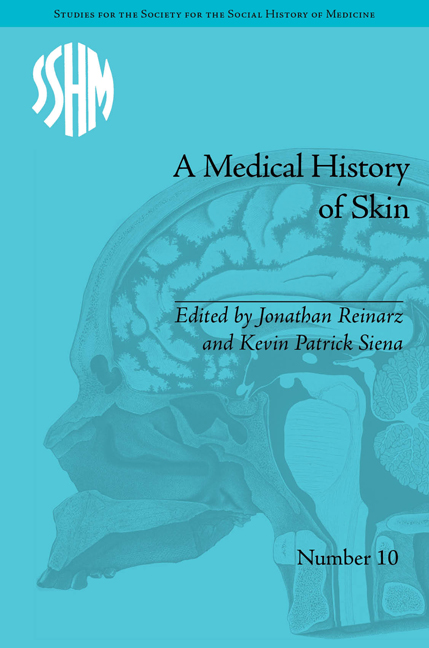Book contents
- Frontmatter
- CONTENTS
- List of Contributors
- List of Figures and Tables
- Scratching the Surface: An Introduction
- Part I The Emerging Skin Field
- 1 Drain, Blister, Bleed: Surgeons Open and Close the Skin in Georgian London
- 2 Abominable Ulcers, Open Pores and a New Tissue: Transforming the Skin in the Norwegian Countryside, 1750–1850
- 3 Protecting the Skin of the British Empire: St Paul's Bay Disease in Quebec
- 4 ‘Italic Scurvy’, ‘Pellarina’, ‘Pellagra’: Medical Reactions to a New Disease in Italy, 1770–1815
- Part II Skin, Stigma and Identity
- Part III Skin, Disease and Visual Culture
- Afterword: Reading the Skin, Discerning the Landscape: A Geo-historical Perspective of our Human Surface
- Notes
- Index
2 - Abominable Ulcers, Open Pores and a New Tissue: Transforming the Skin in the Norwegian Countryside, 1750–1850
from Part I - The Emerging Skin Field
- Frontmatter
- CONTENTS
- List of Contributors
- List of Figures and Tables
- Scratching the Surface: An Introduction
- Part I The Emerging Skin Field
- 1 Drain, Blister, Bleed: Surgeons Open and Close the Skin in Georgian London
- 2 Abominable Ulcers, Open Pores and a New Tissue: Transforming the Skin in the Norwegian Countryside, 1750–1850
- 3 Protecting the Skin of the British Empire: St Paul's Bay Disease in Quebec
- 4 ‘Italic Scurvy’, ‘Pellarina’, ‘Pellagra’: Medical Reactions to a New Disease in Italy, 1770–1815
- Part II Skin, Stigma and Identity
- Part III Skin, Disease and Visual Culture
- Afterword: Reading the Skin, Discerning the Landscape: A Geo-historical Perspective of our Human Surface
- Notes
- Index
Summary
Even the plague, at present so humiliating and devastating to the Turks, seems to introduce a kind of mildness compared to the hideous radesyge. The first cuts the process short, and immediately delivers death one prey after another. The latter torments slowly, kills tardily, destroys unborn generations, and disfigures well formed bodies.
In June 1781 the physician Nicolaus Arbo, practising in the district of Strømsø in eastern Norway, received a letter from a chamber councillor in the neighbouring county of Telemark. The councillor requested that Arbo take compassion on two poor, single male peasants, whom he had met in a ‘most miserable and lamentable state’. Both of them had been discharged from the hospital as incurable, and they now dwelled in a tiny peasants' hut, entirely ostracized by the community, which feared infection. The councillor pitied these two unfortunates, and their ‘utterly deplorable fate’ had triggered his request to the physician. One of them, named Hans, was thirty-six years old. His health had begun deteriorating five years earlier, and the infirmity reappeared a few years later, with ulcers in the throat and under the nose. Eventually the whole lower part of the nasal cartilage and most of the upper lip were completely destroyed by the disease. He looked ‘extraordinarily repulsive’, but his health was otherwise good. The other, John, was thirty years old. His suffering had commenced three years earlier with ulcers in the throat and loss of the uvula. He had also contracted a disease of the chest, and his speech was severely impaired due to shortness of breath and increasing hoarseness. The colour of his face was pale and yellowish.
- Type
- Chapter
- Information
- A Medical History of SkinScratching the Surface, pp. 31 - 42Publisher: Pickering & ChattoFirst published in: 2014



